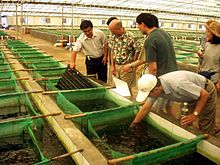Aquaculture in Africa•
•
However, the presence of extensive flood plains provided environment for growth and reproduction of indigenous
species during the rainy season and concentrating them in depressions or
marshes during the dry season. •
Due to
the nomadic nature of most African communities at the time, the
establishment of aquaculture became difficult.
•
This stimulated the early beginnings of
aquaculture in the continent. At the
present time, many initiatives for aquaculture development are being
started in several countries in Africa.
•
Tilapia,
common carp and catfish are the selected species for culture.
•
In Sub Saharan Africa, development of
aquaculture is fairly recent.
•
Most of the aquaculture systems were introduced in the last 35 years. Trout
farming in high altitude areas was introduced in South Africa in 1859 and in Kenya in 1910.
•
Pond
culture of fish was introduced after the Second World War.
•
There was an initial spectacular development
with about tilapia 300,000 ponds established
in approximately 30 African countries by the end of 1950s.
Since then fish culture has not made further progress and in many
cases it has declined resulting in the abandonment
of fish ponds by discouraged farmers.
This poor
performance of aquaculture was attributed to the following :
1.
Poor
husbandry techniques leading to over population of ponds with stunted
tilapia fish
2.
The
dependency on subsidized extension services and fingerling distribution
canters
3.
Poor
policies that failed to correctly identify farmers priorities.
Policy makers assumed that the
primary motivation of farmers was food
and nutritional security, while for most farmers, the main motivation was income generation
4.
Limitation of resources such as capital, water and feed
5.
Inadequate
extension services,
6.
a lack of quality fingerlings,
7.
insufficient training for extension workers
By the end of the
sixties a series of interventions were
initiated by the World Bank to revamp the aquaculture industry.
•
Several measures were introduced such as :
•
modification
of the farming techniques for tilapia in which seed production and
•
grown-out
operations were separated and
•
the
monosex culture of tilapia was introduced
•
In 1995, Sub
Saharan Africa produced 38.8 % of the total volume of fish in Africa from
aquaculture (Table 1) which accounted for 40%
of the total value.
•
In terms of the world aquaculture production Sub
Saharan Africa produced 0.5% of the
total production.
•
Fish consumption has been decreasing steadily as supply decreases relative to a growing
population, from 9 kg per capita in 1990 to 6 kg per capita in currently.
•
There are many factors that favor the
development of aquaculture such as;
– the
underutilized water bodies,
– available
and inexpensive labour,
– high demand for fish and
– a climate that favours an all year
growing fish.

Sub-continent of India.
•
The practice of building water reservoirs of varying sizes as source of water and
for religious purposes, started at very early period in this area.
•
At the beginning, they were not used for fish
culture.
•
Subsequently, however, they were initially used to hold fish and later on to
culture them.

Indonesia.
•
The early development of brackish water aquaculture is attributed to this country at the beginning
of the 15th century.
•
This initiative was spread to neighbouring areas
including the Philippines, Malaysia,
Thailand and southern parts of China (Taiwan).
Europe.
•
Aquaculture in Europe also started during early
period.
•
Palaces of the early rulers, as well as temples and monasteries of the religious, were
provided with water areas.
•
Later on, these were used for temporary holding of fish and subsequently,
they were used as environment for the culture
of fish.
•
Common
carp and trout were recorded as the major species.
Middle East and Israel.
•
Although there are existing rivers which can be focal points of development for
aquaculture in this region, early historical records did not mention any early aquaculture activities. Religious tradition in this area,
however, indicated heavy utilization of fish for food.
•
Present development show that much progress in
aquaculture has occurred in the area especially in Israel.
•
Here carp
and tilapia culture have attained advanced state, and the other countries
in the region have initiated aquaculture
development programs.

Japan and Korea.
•
There is no doubt that aquaculture developed in
these two countries during very early
period.
•
Perhaps China
had some influences in this development such as in the use of goldfish and
carp for culture.
•
But at same period in their history especially
in Japan, the "closed door policy"
was enforced in that country.
•
At that time aquaculture continued to flourish
especially in the culture of a very wide
variety of species.
•
This is probably the reason why in that country
most any aquatic species of high
economic value are subjected to culture - fin fishes, crustaceans,
molluscs, other vertebrates and many kinds of marine invertebrates that could
be the subject of trade.
•
Development of efficient and high culture technology is also a characteristic of
Japanese and Korean aquaculture.
North America.
•
There were attempts to develop aquaculture
during the 19th century specially aimed
at the development of sport fishing.
•
A book, A Manual of Fish Culture, was published
by the United States Commission of Fish and Fisheries in 1897.
•
This dealt mainly on established hatcheries for
the production of seeds to stock game
waters but also includes some food
species of finfish, oysters, clams, etc.











0 Comments:
Post a Comment